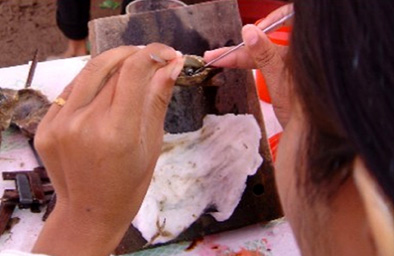
Although both natural saltwater and freshwater pearls have all been highly coveted, rare, and valuable gems throughout human history, saltwater pearls were the first to be successfully cultured by man. These creations of the cooperation between man and mollusk increasingly dominated the world pearl market from the early 1930's until about 20 years ago when they were challenged, and then superseded, by freshwater cultured pearls. By the 1950's SWCP were the market, with natural pearls sought only by the rare gem collector, and antique jewelry fan. As I have written previous essays on both natural pearls and freshwater cultured pearls, I will focus my attention in this piece on pearls grown commercially in marine oysters of various species.
A number of individuals were important in developing and perfecting the pearl culturing process used today for SWCP, but to be fair, the lion's share of the credit must be given to Kokichi Mikimoto. He was tireless, not only in research and development, but more importantly in marketing, and creating acceptance for the finished product. Without his zeal and persistence in championing the term "cultured", it almost inevitable that "synthetic" or "man-made" would be the adjective used today to describe these gems. Technically, as well, the basics of all the saltwater pearl culturing operations of today, regardless of the type of oyster, or the geographic location, are the same as are those pioneered by Mr. Mikimoto.
1) Oysters, either collected from the wild, or more commonly today, bred in controlled facilities, are opened in a labratory-like facility, and "nucleated" with a shell bead (and a piece of oyster mantle tissue). Highly skilled "surgeons" perform the insertion of the bead into the gonad of the animal, taking care to promote survival by minimizing internal damage. Unlike freshwater mollusks, which accept dozens of nucleations, most saltwater species can accept but one or two. This is partially responsible for the price differential.

2) The oysters are returned to the sea protected within special rafts or cages to underwater "pearl farms" to grow and produce the nacre layers which cover the bead, and create the pearl. The time necessary varies from six months to several years depending on the size of the bead, the species of oyster, the temperature and other environmental conditions of the water, and the quality of the pearl being sought. Nacre is composed of mineral crystals layered between a protein secretion known as conchiolin.
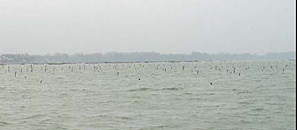
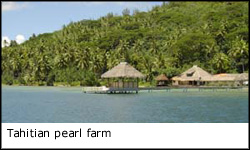
Mortality from the nucleation process, and from subsequent disease, water pollution, and weather disasters makes the success rate relatively low, especially in comparison to freshwater culturing where conditions can be more closely controlled.
3) The pearls are harvested, cleaned, sorted and graded by size, quality and color. Color depends on the species of oyster, size is controlled by the size of the bead the animal can accept, and quality is primarily related to the thickness and structural characteristics of the nacre layer. In general, longer in the ocean = thicker nacre, cooler water conditions = more uniform crystals. Depending on the producer and the type of pearl, various enhancements such as bleaching, polishing or dyeing may follow.
SWCP differ in size, color and geographic location where they can be grown, mainly due to species differences between the several different oysters that are farmed. (Depending on whether the writer is a "lumper" or a "splitter" when it comes to categorizing things, the number of types differ from four or five to as few as two. Most commonly, the whole group is often divided into three categories: Akoyas, Tahitians and South Seas pearls, so I will stick with that nomenclature.)

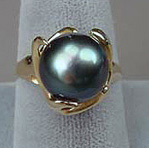
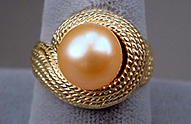
With one exception, the various oysters which produce all types of SWCP are species belonging to the genus Pinctada. For example: Pinctada imbricata, P. margarifera, and P. maxima. (For those not fluent in biological taxonomy this means they are about as related to each other, and as different in their ecological niche, size and outward appearance as are Felis leo, F. domesticus and F. concolor (all cats: lion, house cat, cougar).
Rather than use the cumbersome scientific names, though, I'll use the common names which have the additional advantage of giving us hints about the color, geographic range and/or size of the pearls we can expect. They are, in order: the Japanese or "Akoya" oyster, the black lipped oyster, and the silver/gold lipped oyster. The term "lip" refers to the inner rim of the shell that is most characteristic of the mother of pearl color, and therefore most likely to be that of the cultured pearl. (A member of one other genus is just beginning to be cultured in the Sea of Cortez, Pteria sterna, commonly called the rainbow lipped oyster. None of the pearl oysters, by the way, are closely related to the edible oyster, so enjoy those for their taste or nutritional value, but don't expect the bonus of a "pearl" reward.
The Japanese pearl oyster, native to the cool to temperate seas surrounding Japan, with which Mikimoto began today's multibillion dollar industry, is also known as the "Akoya" oyster, and all pearls produced from this species, whether in Japan or elsewhere, are called Akoya pearls. The animal is small in size, grows slowly, and has a little gonad which will accept only a small bead nucleus. The upper size limit of Akoyas is about 8 mm, and most are smaller. Their natural color range is white, cream, and very subtle pastel shades of silver, tan and pink. Although the nacre layer is generally relatively thin, ( .5 mm - .8 mm) the highly uniform mineral crystals which form in the cool waters give this pearl exquisite luster. Orient, that shifting iridescence sometimes seen on the surface of pearls is usually subtle if present at all. Due to the wide variation in finished size, luster and color, matched strands of high quality Akoyas can be very expensive, especially in larger sizes. The Mikimoto Company continues to retain its reputation for quality (and its top level prices), but many other companies offer Akoyas in a range of qualities and prices.

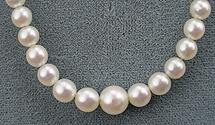
The motivation to enhance Akoyas is great, as most have uneven color or dark nucleus spots that can be eliminated by bleaching or slight surface imperfections that can be made less noticeable by polishing. Many Akoya producers use at least these minimal treatments, and some use dyes or irradiation to change color. Those who wish to purchase unenhanced, or minimally enhanced, Akoyas are going to pay a premium for the enormous grading effort and time it takes to produce carefully matched strands.
At least two decades ago, the freshwater cultured pearl industry which began in Japan at Lake Biwa, and due to pollution, disease, over harvesting, and other problems lost the biggest share of the market to "newcomers" from China. The same nightmare is again playing itself out for Japanese Akoya pearl growers. High labor costs, bad weather, pollution and disease have made the Japanese Akoya noticeably higher priced than the newer crops produced in Chinese waters. Initially the quality difference helped maintain Japanese dominance, but as the Chinese product improved in quality, the inevitable happened. Today the majority of Akoyas sold come from China, and within single strands from even top level brands contain pearls produced from both Japanese and Chinese waters.
The products of the black lipped oyster, which grows in a wide area of ocean in the Pacific including French Polynesia and Micronesia, are generally larger than Akoyas (10 mm is common), and range in color from very dark grey to lighter grey and silver, although they are often generically referred to a "black pearls". Their body colors can show overtones of green, pink, lavender, bronze or olive, and they commonly show a strong iridescent display of orient. The reason for their larger size is due to the fact the the oyster itself is larger, and has a bigger gonad which will accept a larger shell bead than the Akoya. The warm, clean waters, help the oysters to grow relatively quickly and be harvested with a relatively high success rate.
The nacre layer is generally a lot thicker than in the Akoya, and recent vigilant efforts of the Tahitian pearl industry to enforce growing time and grading standards has reversed the inevitable drive to produce large quantities of thin layered pearls. Many Tahitians are baroque in shape (as seen below), and can be relatively inexpensive but rounds, especially large ones in matched strands are extremely expensive.
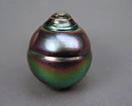

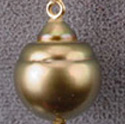
There are two subspecies or varieties of the South Sea pearl oyster: the silver lipped and the gold lipped. It is the largest in size of all the pearl oysters and produces pearls of 13 mm on average, some much larger. The range is from the waters North of Australia to those South of China, including Indonesia. The site of the richest yellow/gold pearls centers around Indonesia so these are often referred to as "Indonesian" golden pearls. Clean water with rich supplies of plankton encourages fast growth: after 2 years, 2 - 6 mm of nacre may be deposited. Orient is not usually a strong feature, but the warm colors and satiny luster give these large beauties a special appeal. The color range is wide, including creamy white, tan, grey, yellow and gold. Rare colors like a green/gold sometimes called "pistachio" bring a premium.
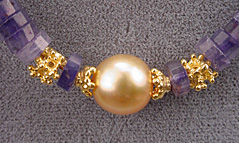
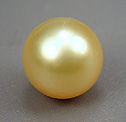
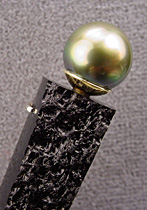
As with Akoyas, both Tahitian and South Sea pearls can be enhanced by dye or with an irradiation process which darkens the shell nucleus, although such treatments not yet the norm, as are bleaching and light polishing. Dyed or irradiated pearls can sometimes be detected by observing the pearl, and especially the drill hole, at high magnification. Dyes, which affect only the nacre layer, might be seen as concentrations of color near the drill hole or in surface imperfections. Irradiation darkens the inner shell nucleus, not the nacre, so in this case an abrupt difference in color between the nacre and the bead seen at the drill hole will be definitive. A natural colored strand of Tahitians or South Sea pearls can be expected to show slight color variations from pearl to pearl, whereas a strand of dyed pearls will be quite uniform. This observation is less likely to be helpful with Akoyas, where bleaching is more commonly used as an aid to color matching.
Cultured blister pearls are formed when a nucleus is attached to the oyster's (or abalone) shell rather than implanted in the gonad. These have a long history, and were actually produced as curiosities long before the days of Mikimoto. When a blister pearl is removed from the shell, the bead extracted, and the cavity filled with an epoxy resin, then given a flat shell backing, the result is called a Mabe pearl. Technically termed an "assembled cultured pearl product", they are lustrous, can be formed in interesting shapes, and give the buyer a lot of pearl and nacre "bang for the buck".
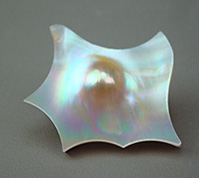

Faux pearls go back hundreds of years, and can be as cheap and obvious as molded plastic, or carefully made and nearly as expensive as freshwater cultured pearls. The premier brand of imitation pearls, Majorcas, with a heritage of cottage industry manufacture going back to the 19th century, still have a loyal following today.
Short of examining the pearl surface at 50X magnification to detect the overlapping layers of nacreous plates, the old standby test is to gently run the pearl over the edge of your bottom teeth. A slight, but noticeable gritty texture, indicates a cultured pearl, a smooth texture, an imitation.
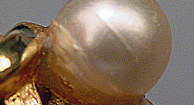
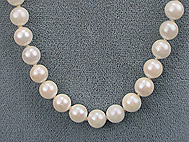
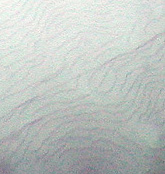
It is true that pearls are delicate, but they are tougher than their statistics might indicate. Hardness of 3 and sensitivity to heat and chemicals on the downside, is partially compensated for by surprisingly good toughness. A pearl's ability to resist chipping and breaking is due to the "bricks and mortar" nature of the nacreous coating. So, with a saltwater cultured pearl, nacre thickness is the key not only to beauty, but also to durability. Inexpensive pearls (especially Akoyas), may have extremely thin nacre layers (less than .5 mm), due to very short growth times. Although these bargain pearls may look pretty good when new, they will rapidly degrade as the fragile nacre layer chips or flakes off, and the dull bead underneath is revealed. Large size in pearls is a tempting quality, but given the same amount of money to spend, a smaller pearl with a thicker nacre layer will be the better investment in lasting beauty.
Pearls should be wiped with a damp cloth after wearing, and rare cleaning in mild soapy water is all that's required. Under no circumstances should they be placed in an ultrasonic or steam cleaner. Pearls should be given their own, cloth lined compartments in a jewelry case, not thrown in a jumble with diamond and colored gemstone jewelry. Jewelry settings in rings and bracelets should be protective, or if not (as in many pearl rings) the piece should be considered for occasional use only, rather than daily wear.
Pearl strands of substantial monetary or sentimental value, if worn frequently, should be restrung every year or two. This caution is not primarily due to the string weakening and being likely to break. Rather the worry is that as pearls loosen on the strand due to stretching of the string (which is inevitable with wear), the knots become free twist and to abrade the nacre/bead junction, and damage the pearl.
I am speculating, but I think it's pretty safe to say that although many more freshwater than saltwater cultured pearls are sold, the dollar value of the latter far exceeds the former. From the earliest days of pearl culturing at the turn of the 20th century, into the 60's when cultured freshwater pearls first began to enter the market, and still, today, saltwater pearls have been considered to be finer in quality, and are the most expensive type. So many factors go into the valuation of saltwater cultured pearls that it is difficult to make any generalizations. Suffice it to say that the more lustrous, beautifully colored, large and if in strands, the more well matched pearls are, no matter what the species of oyster that produced them, the more they will cost. Rare colors, thick nacre, iridescent orient, lack of enhancements, and exceptional size will bring premium prices.